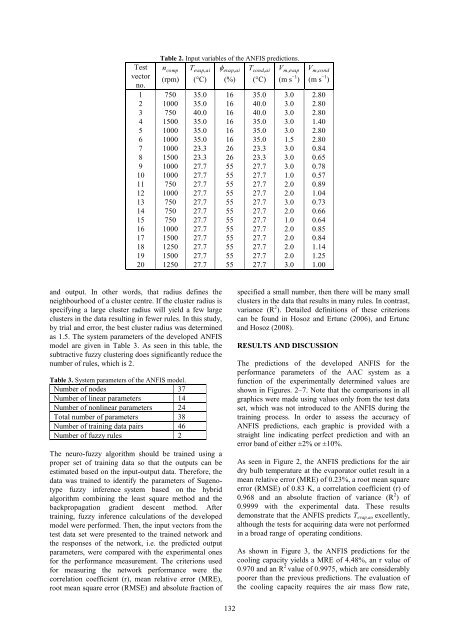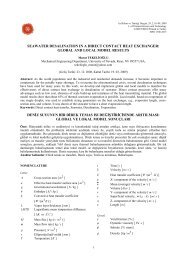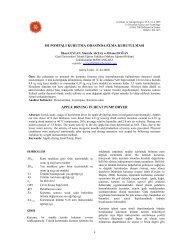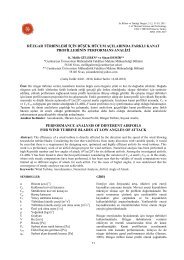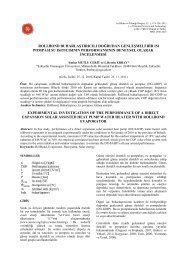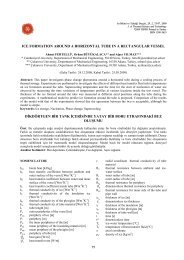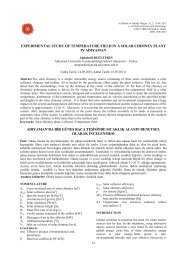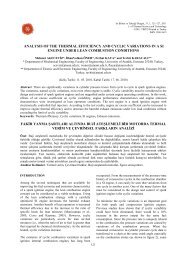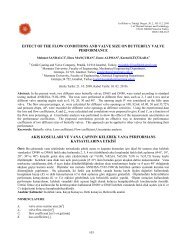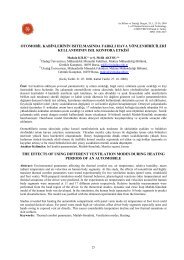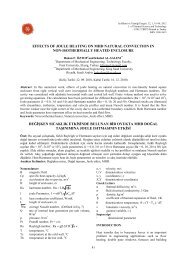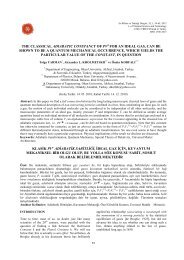modelling of an automotive air conditioning system using anfis
modelling of an automotive air conditioning system using anfis
modelling of an automotive air conditioning system using anfis
Create successful ePaper yourself
Turn your PDF publications into a flip-book with our unique Google optimized e-Paper software.
Test<br />
vector<br />
no.<br />
Table 2. Input variables <strong>of</strong> the ANFIS predictions.<br />
n<br />
<br />
comp<br />
(rpm)<br />
T evap,<br />
ai<br />
(°C)<br />
evap,ai<br />
(%)<br />
T cond,<br />
ai<br />
(°C)<br />
V m , evap<br />
(m s −1 )<br />
V m , cond<br />
(m s −1 )<br />
1 750 35.0 16 35.0 3.0 2.80<br />
2 1000 35.0 16 40.0 3.0 2.80<br />
3 750 40.0 16 40.0 3.0 2.80<br />
4 1500 35.0 16 35.0 3.0 1.40<br />
5 1000 35.0 16 35.0 3.0 2.80<br />
6 1000 35.0 16 35.0 1.5 2.80<br />
7 1000 23.3 26 23.3 3.0 0.84<br />
8 1500 23.3 26 23.3 3.0 0.65<br />
9 1000 27.7 55 27.7 3.0 0.78<br />
10 1000 27.7 55 27.7 1.0 0.57<br />
11 750 27.7 55 27.7 2.0 0.89<br />
12 1000 27.7 55 27.7 2.0 1.04<br />
13 750 27.7 55 27.7 3.0 0.73<br />
14 750 27.7 55 27.7 2.0 0.66<br />
15 750 27.7 55 27.7 1.0 0.64<br />
16 1000 27.7 55 27.7 2.0 0.85<br />
17 1500 27.7 55 27.7 2.0 0.84<br />
18 1250 27.7 55 27.7 2.0 1.14<br />
19 1500 27.7 55 27.7 2.0 1.25<br />
20 1250 27.7 55 27.7 3.0 1.00<br />
<strong>an</strong>d output. In other words, that radius defines the<br />
neighbourhood <strong>of</strong> a cluster centre. If the cluster radius is<br />
specifying a large cluster radius will yield a few large<br />
clusters in the data resulting in fewer rules. In this study,<br />
by trial <strong>an</strong>d error, the best cluster radius was determined<br />
as 1.5. The <strong>system</strong> parameters <strong>of</strong> the developed ANFIS<br />
model are given in Table 3. As seen in this table, the<br />
subtractive fuzzy clustering does signific<strong>an</strong>tly reduce the<br />
number <strong>of</strong> rules, which is 2.<br />
Table 3. System parameters <strong>of</strong> the ANFIS model.<br />
Number <strong>of</strong> nodes 37<br />
Number <strong>of</strong> linear parameters 14<br />
Number <strong>of</strong> nonlinear parameters 24<br />
Total number <strong>of</strong> parameters 38<br />
Number <strong>of</strong> training data p<strong>air</strong>s 46<br />
Number <strong>of</strong> fuzzy rules 2<br />
The neuro-fuzzy algorithm should be trained <strong>using</strong> a<br />
proper set <strong>of</strong> training data so that the outputs c<strong>an</strong> be<br />
estimated based on the input-output data. Therefore, the<br />
data was trained to identify the parameters <strong>of</strong> Sugenotype<br />
fuzzy inference <strong>system</strong> based on the hybrid<br />
algorithm combining the least square method <strong>an</strong>d the<br />
backpropagation gradient descent method. After<br />
training, fuzzy inference calculations <strong>of</strong> the developed<br />
model were performed. Then, the input vectors from the<br />
test data set were presented to the trained network <strong>an</strong>d<br />
the responses <strong>of</strong> the network, i.e. the predicted output<br />
parameters, were compared with the experimental ones<br />
for the perform<strong>an</strong>ce measurement. The criterions used<br />
for measuring the network perform<strong>an</strong>ce were the<br />
correlation coefficient (r), me<strong>an</strong> relative error (MRE),<br />
root me<strong>an</strong> square error (RMSE) <strong>an</strong>d absolute fraction <strong>of</strong><br />
specified a small number, then there will be m<strong>an</strong>y small<br />
clusters in the data that results in m<strong>an</strong>y rules. In contrast,<br />
vari<strong>an</strong>ce (R 2 ). Detailed definitions <strong>of</strong> these criterions<br />
c<strong>an</strong> be found in Hosoz <strong>an</strong>d Ertunc (2006), <strong>an</strong>d Ertunc<br />
<strong>an</strong>d Hosoz (2008).<br />
RESULTS AND DISCUSSION<br />
The predictions <strong>of</strong> the developed ANFIS for the<br />
perform<strong>an</strong>ce parameters <strong>of</strong> the AAC <strong>system</strong> as a<br />
function <strong>of</strong> the experimentally determined values are<br />
shown in Figures. 2–7. Note that the comparisons in all<br />
graphics were made <strong>using</strong> values only from the test data<br />
set, which was not introduced to the ANFIS during the<br />
training process. In order to assess the accuracy <strong>of</strong><br />
ANFIS predictions, each graphic is provided with a<br />
straight line indicating perfect prediction <strong>an</strong>d with <strong>an</strong><br />
error b<strong>an</strong>d <strong>of</strong> either ±2% or ±10%.<br />
As seen in Figure 2, the ANFIS predictions for the <strong>air</strong><br />
dry bulb temperature at the evaporator outlet result in a<br />
me<strong>an</strong> relative error (MRE) <strong>of</strong> 0.23%, a root me<strong>an</strong> square<br />
error (RMSE) <strong>of</strong> 0.83 K, a correlation coefficient (r) <strong>of</strong><br />
0.968 <strong>an</strong>d <strong>an</strong> absolute fraction <strong>of</strong> vari<strong>an</strong>ce (R 2 ) <strong>of</strong><br />
0.9999 with the experimental data. These results<br />
demonstrate that the ANFIS predicts T evap,ao excellently,<br />
although the tests for acquiring data were not performed<br />
in a broad r<strong>an</strong>ge <strong>of</strong> operating conditions.<br />
As shown in Figure 3, the ANFIS predictions for the<br />
cooling capacity yields a MRE <strong>of</strong> 4.48%, <strong>an</strong> r value <strong>of</strong><br />
0.970 <strong>an</strong>d <strong>an</strong> R 2 value <strong>of</strong> 0.9975, which are considerably<br />
poorer th<strong>an</strong> the previous predictions. The evaluation <strong>of</strong><br />
the cooling capacity requires the <strong>air</strong> mass flow rate,<br />
132


